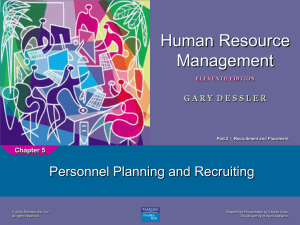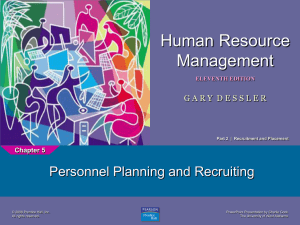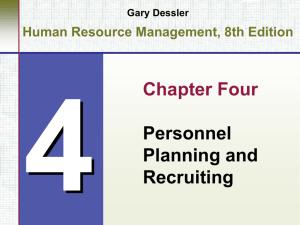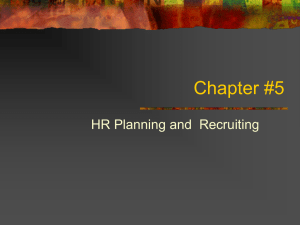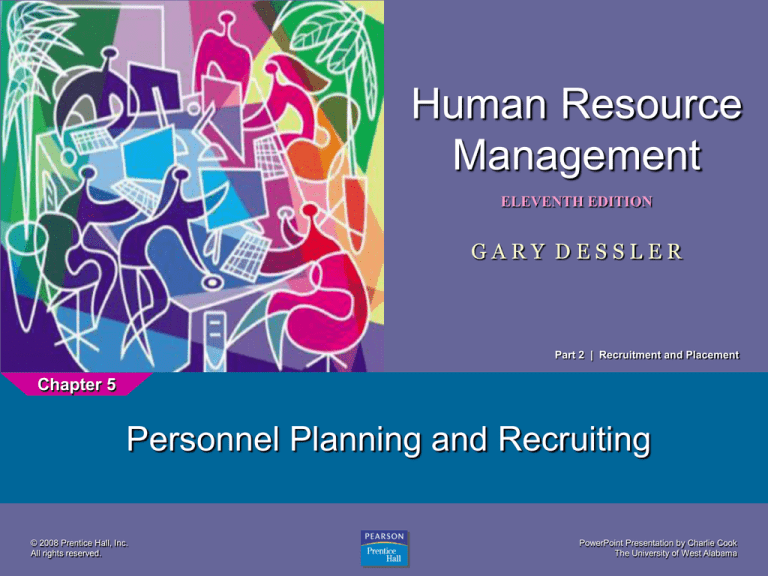
Human Resource
Management
ELEVENTH EDITION
1
GARY DESSLER
Part 2 | Recruitment and Placement
Chapter 5
Personnel Planning and Recruiting
© 2008 Prentice Hall, Inc.
All rights reserved.
PowerPoint Presentation by Charlie Cook
The University of West Alabama
After studying this chapter, you should be able to:
1. Explain the main techniques used in employment
planning and forecasting.
2. List and discuss the main outside sources of
candidates.
3. Effectively recruit job candidates.
4. Name and describe the main internal sources of
candidates.
5. Develop a help wanted ad.
6. Explain how to recruit a more diverse workforce.
© 2008 Prentice Hall, Inc. All rights reserved.
5–2
Planning and Forecasting
• Employment or Personnel Planning
The process of deciding what positions the firm
will have to fill, and how to fill them.
• What to Forecast?
•
Overall personnel needs
• The supply of inside candidates
• The supply of outside candidates
© 2008 Prentice Hall, Inc. All rights reserved.
5–3
Forecasting Personnel Needs
Forecasting
Tools
Trend Analysis
© 2008 Prentice Hall, Inc. All rights reserved.
Ratio Analysis
Scatter Plotting
5–4
Forecasting the Supply of
Inside Candidates
Qualification
Inventories
Manual
Systems and
Replacement
Charts
© 2008 Prentice Hall, Inc. All rights reserved.
Computerized
Information
Systems
5–5
Effective Recruiting
• Employee Recruiting:
Finding and/or attracting applicants for the
employer’s open positions.
Why Recruiting is Important?
• Effective recruiting is increasingly important.
• With the dramatic changes, recruiting is
becoming more challenging , and there will
soon be an undersupply of workers.
© 2008 Prentice Hall, Inc. All rights reserved.
5–6
Measuring Recruiting Effectiveness
Evaluating
Recruiting
Effectiveness
What to
Measure
© 2008 Prentice Hall, Inc. All rights reserved.
How to
Measure
5–7
Finding Internal Candidates
Rehiring Former
Employees
Job Posting
Hiring from
Within
Succession
Planning (HRIS)
© 2008 Prentice Hall, Inc. All rights reserved.
5–8
Outside Sources of Candidates
• Locating Outside Candidates
1. Advertising
2. Recruiting via the Internet
3. Employment Agencies
4. College Recruiting
© 2008 Prentice Hall, Inc. All rights reserved.
5–9
Employment Agencies
Types of Employment
Agencies
Public
Agencies
© 2008 Prentice Hall, Inc. All rights reserved.
Nonprofit
Agencies
Private
Agencies
5–10
Recruiting A More Diverse Workforce
Single Parents
The Disabled
Welfare-to-Work
© 2008 Prentice Hall, Inc. All rights reserved.
Older Workers
Minorities and
Women
5–11
Developing and Using Application Forms
Uses of Application
Information
Applicant’s
education and
experience
Applicant’s
progress and
growth
© 2008 Prentice Hall, Inc. All rights reserved.
Applicant’s
employment
stability
Applicant’s
likelihood of
success
5–12
Application Forms and the Law
Education
Achievements
Arrest
Record
Housing
Arrangements
Areas of
Personal
Information
Marital
Status
Physical
Handicaps
© 2008 Prentice Hall, Inc. All rights reserved.
Notification in
Case of
Emergency
Memberships in
Organizations
5–13
KEY TERMS
employment or personnel
planning
trend analysis
ratio analysis
scatter plot
computerized forecast
qualifications inventories
© 2008 Prentice Hall, Inc. All rights reserved.
job posting
succession planning
application form
5–14

